Displaying items by tag: Kitesurfing
Jade O'Connor Moves Up Kiteboard World Rankings in China
#kitesurfing – The skies of Bo'ao, Hainan, China have never looked so busy after two days of solid racing as 140 plus sailors from 45 countries compete at the Kiteboard Racing World Championships.Irish Sailor Jade O'Connor moved up the rankings of the ladies fleet today. She's currently positioned 12th overall with an improving scoreline, posting a 10th and 7th in race 5 & 6 respectively.
ISAF Sailors Of The Year nominees Erica & Johnny Heineken stamp their authority with an obvious speed and angle advantage. The remaining places are hard fought amongst the worlds best kite racers in testing conditions with solid winds over 20 knots for the last two days and set to continue for the remainder of the event.
O'connor declared after racing today – 'Super happy!!! I'm riding like i'm on fire, a couple of shockers when I get taken out on the start by other sailors or trash in the water catching my fins but that's racing, and the same for everyone else. After 2 days I'm 12th overall at the World Championships with a scoreline of 15, 26, 16, 14, 10, 7, 14'.
Kitesurfing Will Be 'First Alternate' At Tokyo 2020
#Kitesurfing - There's been some good news for kitesurfing on the Olympic front as Surfer Today reports that the kiteboarding class will be the first alternate for the Tokyo Games in 2020.
It was announced at the 2013 ISAF Annual Conference in Oman that kiteboarding will be first in line if additional medals are allocated by the International Olympic Committee (IOC) for sailing in Tokyo in seven years' time.
In addition, the ISAF Council decided that class status will be awarded to the Formula Kiteboard and Twin Tip Kiteboard among a number of newly recognised sailing classes.
The news follows the recent message from the ISAF that kitesurfing would add an 'urban sport' feel to the Olympic programme should it be reinstated.
Kitesurfing was to be included in Rio 2016 at the expense of windsurfing only for the decision to be reversed in Dun Laoghaire a year ago.
Kitesurfers Want Action Over Dublin Beach Thefts
#Kitesurfing - "Countless" numbers of vehicles belonging to kitesurfers and other beach users have been broken into on Dublin beaches over the past year, according to the Irish Kite Surfing Association (ISKA).
And as the Dublin People reports, the problem only seems to be getting worse - with three cars damaged and burgled at Burrow in Sutton and Dollymount Strand on Bull Island over the weekend of 12-13 October last.
According to ISKA secretary Nicola Murphy, the latest spate of break-ins occurred despite an additional Garda presence for a kitesurfing event in Sutton that weekend.
And the brazen nature of the broad-daylight thefts has both kitesurfers and local beach users concerned, with tourists among those falling victim to what's being described as a very organised criminal activity.
The Dublin People has more on the story HERE.
Kitesurfing Would Bring 'Urban Sport' Feel To Olympics Says ISAF
#Kitesurfing - Kitesurfing would add an 'urban sport' feel to the Olympic programme and should be reconsidered for inclusion in future Olympic Games.
That's the message according to the International Sailing Federation (ISAF) in the minutes of its recent Executive Committee meeting in Paris (available as a PDF to read or download HERE).
In his report on recent activities, ISAF president Carlo Croce related that a "constructive meeting" had taken place with the International Olympic Committee (IOC) with a view to the possibility of adding kitesurfing to the list of Olympic sports in future.
On a similar note, a decision was taken to send a letter to the organisers of the Mediterranean Games asking them to consider hosting kitesurfing at their next event in Spain in 2017.
The ISAF's interest in kitesurfing is no surprise, given last year's move to include the new sport at the Rio Games in 2016 at the expense of windsurfing, only for the decision to be reversed at the federation's AGM in Dun Laoghaire last November amid accusations over the new sport's allegedly 'dangerous' reputation.
That was something of a bitter blow at the time to Claudine Murphy - sister of Olympic hero Annalise - who had been campaigning in the new class.
However, she has since teamed with Andrea Brewster to challenge for a spot in the 49er FX skiff class - and hopefully make it a sister act with her younger Laser-racing sibling in Brazil less than three years from now.
Achill Island Welcomes Kitesurfers For Irish Tour's Last Stop
#Kitesurfing - It will be last kite flying when Ireland's kitesurfers take to the water on Achill Island this weekend 28-29 September to battle some of the best in the world at the final stop on the Irish Kitesurfing Tour Competition.
As the Mayo Advertiser reports, the kitesurfing event will be celebrated on dry land, too, with the Battle for the Lake Music and Kite Festival, as spectators watch all the action on Keel Lake - considered one of the world's best spots for the sport - and enjoy live music, a funfair and BBQ on the lakeshore.
The Mayo Advertiser has more on the story HERE.
Kitesurfer Completes Historic First from France to Ireland
#kitesurfing – French professional kitesurfer Bruno Sorca, has completed the first ever passage from France to Ireland adding to his English Channel record. The crossing was completed last night, and he was welcomed in to the Royal Cork Yacht Club in Crosshaven.
Having conquered this latest adventure, the talented kitesurfer admits he is already eyeing up his next challenge; a New York to Brest kitesurf crossing in 2015.
At 5.20 am yesterday morning July 19th, Sroka, a triple world champion kitsurfer, left Penn enez beach at the Aber Wrac'h in Brittany to achieve his long-awaited crossing heading towards Crosshaven Cork, Ireland writes Claire Bateman.
With a 16 knots speed north-east wind he started with his kitesurf in the colours of Ireland for 240 nautical miles (444 km). It's the first time ever that a kitesurfer undertook and successfully completed such a challenge.
He hoped to complete this challenge in about 16/17 hours and reach the other side of the Channel in or around 10.00 pm. All this he did and what a finish it made.
It was not easy to establish his whereabouts but a number of RIBS and sailing craft set out to the area of Roches Point approximately 9 pm prepared to wait for the arrival. It was a lovely evening to await the three times World Champion Kitesurfer. However, the sun went down in a brilliant blaze of light over the harbour and the moonbeams started to cast their light on the water. Where was the Kitesurfer and his support. Suddenly some of the boats started to leave Roches Point and took off in a south south east direction your scribe and photographer amongst them. Equally suddenly as if from nowhere a posse of RIBs came from behind to join in. Next thing the whole posse returned at a screaming pace towards Crosshaven encircling the triumphant Kitesurfer aboard his support boat which he had boarded at the outer mouth of he harbour.
It was truly like a scene from a James Bond movie, the moon casting this shimmering glow on the water, the twinkling lights of the speeding boats, the flashing of the cameras with everybody trying to get a glimpse of Bruno Sroka who was clenching his hands in triumph and delight . The wash from the boats was unbelievable to be speeding through, I don't think I have ever experienced anything quite like it!!

Professional kitseurfer Bruno celebrates his arrival into Cork Harbour last night shortly after finishing his 244-mile journey from France. Photo: Bob Bateman
The Royal Cork Yacht Club was a blaze of welcoming lights and the boats moored on the marina were filled with sailors applauding the triumphant kitesurfer and the lawn area was also lined with more members applauding enthusiastically. The welcoming gathering included the Minister for Agriculture, Food and the Marine, Simon Coveney TD, at home in his club accompanied by his little daughter and a very large black dog!!
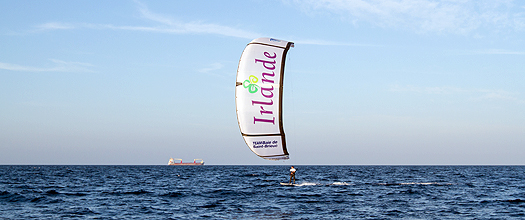
Kitesurfer Bruno nears the Irish coast last night. Photo: Francois Van Malleghem/
Once ashore Bruno was surrounded by well wishers and admires with all seeking autographs and wishing to be photographed with him. Here,this gracious and charming young Frenchman must be commended that in his complete state of exhaustion he found time or everyone that wanted to speak with him and sake his hand.
The journey was within his anticipated time and he must be feeling extremely proud and happy that he had come from Brittany to Cork Harbour the longest kitesurf to be completed to date
This morning will see a reception hosted at the Clubhouse where Bruno Sroka's amazing feat will be recognised.
Official press release below:
Mission accomplished, Bruno Sroka reached his goal ! Yesterday morning, 19 of July, at 6.25 a.m three times World champion Bruno Sroka left from the Penn Enez beach at l’Aber Wrac’h, Brittany and joined Crosshaven, the bay of Cork, Ireland at 22:02 p.m.(local time) by kite. After 16hours and 37 mins of sailing Bruno realised one of his dreams ! He managed to kite 240 nautical miles (444km) in a row and reach the glorious victory ! He became the first kitesurfer that did France Ireland crossing !
In the diming day light Bruno was greeted by dozen of boats that came up to meet him at the entrance of the Crosshaven, bay of Cork.
Tired but very happy at the same time Bruno was nicely surprised of this amazingly friendly crowd greeting him at the harbour. « We did it ! I can’t believe it’s over ! I am so pleased to see all of these boats that came to celebrate my arrival ! I am very happy ! » says Bruno.
« It was very difficult but today I feel proud of what I have done ! I had rather good wind during the biggest part of the crossing and the last part of it was the hardest one. The wind was dieing rapidly and I was obliged to change the boards that I was riding. No matter what all that count is to arrive to the finish line ! And thats what I did ! I do feel pain in most of the parts of my body but this is something temporary that I will forget about meanwhile the glory of victory – never ! »
Bruno Sroka accomplished his first crossing of the three year crossing series with the grand final New York – Brest kitesurf crossing in 2015
Kitesurfing Adventurer Plans Crossing From France to Ireland
#Kitesurfing - Bruno Sroka aims to complete an epic solo journey from France to Ireland on his kitesurfing board, powered only by the waves and the wind.
As Surfer Today reports, the French kitesurfer - who already has a crossing of the English channel to his credit - has set himself the challenge next month of surfing from L'Aber-Wrac'h in Brittany to the south coast of Ireland, a distance of some 240 nautical miles.
And it will be just the first of three adventures Sroka has lined up for himself, as he aims to follow this feat with a crossing of the Mediterranean in 2014, and finally the mighty Atlantic Ocean in 2015.
Indeed, his ambitious plans do little to dispel the impression that kitesurfing is a sport for the bravest alone - even too dangerous for the Olympics!
Surfer Today has more on the story HERE.
Pro Kitesurfer Ruben Lenten Gets Big Air In Ireland
#Kitesurfing - Another video for this chilly day, this time of professional kitesurfer Ruben Lenten as he takes it to the extreme in Ireland and the Netherlands.
The footage on YouTube shows the Red Bull team member getting some big winter air off the west coast of Ireland - and storm chasing closer to home off the Dutch coast. Better him than us!
Achill Island Attracts Kitesurfers The World Over
#Kitesurfing - “There’s loads of special places in the world, but none of them are Achill,” says kitesurfing instructor Francois Colussi. “There’s something magical here.”
And if this article from TNT Magazine is anything to go by, you'll be sure to agree.
The writer recently spent a short break on the weather-worn but ruggedly beautiful island in Co Mayo that has in recent years become a winter haven for kitesurfers the world over - drawn to the winds and waves that made it the perfect choice to host the Aer Lingus Kite Surf Pro in October.
Those are the same qualities that brought in Frenchman Colussi, who has since turned a former local pub near Keel beach into kitesurfing school Pure Magic.
Indeed, you don’t have to be a professional to kitesurf in Keel. “It’s one of the most extreme sports, but the most accessible. It’s much easier that surfing or windsurfing. You can learn in a weekend,” Colussi tells TNT. “You don’t need huge upper body strength – you’re powered by the wind.”
Even so, at this time of year it's a place for the hardier souls, as Welsh world champ Kirsty Jones describes: “The ocean is pure, Atlantic water. You feel a slap in the face like – Yes! I’m alive!”
TNT Magazine has more on the story HERE.
Sailrocket 'Smashes' World Speed Sailing Record
#SPEED RECORD - Weymouth-based sailor Paul Larsen and his crew have laid claim to a new world record in speed sailing, as BBC News reports.
The team say they achieved an average speed of over 59 knots - with a peak of 63.5 knots - on a half-kilometer run at Namibia's Skeleton Coast using their purposely designed Vestas Sailrocket 2.
Their speed "smashed" the previous record of 55.65 knots set by kitesurfer Rob Douglas in the 2010 Luderitz Speed Challenge, although it is yet to be confirmed by the World Speed Sailing Records Council.
It was the culmination of 10 years' hard work on the part of Australian-born Larsen and his team, using the specially adapted design built on the Isle of Wight - a vessel that's "very impractical in conventional sailing terms", as Larsen told the Times.
He added: "We are buzzing — no-one has done this with a sailing boat before... This shows how unique and revolutionary the boat is.
"We’ve had to break the boundaries of sailing — like the equivalent of our sound barrier — just over 50 knots."
The boat's designer Chris Hornzee-Jones said the vessel - inspired by the success of speed sailing kitesurfers and windsurfers like Oisín can Gelderen - was key to their breakthrough.
"It is designed to be an ideal testing platform for trialling new foil concepts which will allow us to break through this 'glass ceiling' and perform at speeds well over 60 knots.”



























